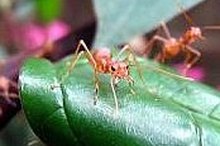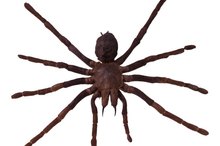How to Identify Insect & Mite Bites
Have you ever started itching and scratching and noticed a few bumps on your skin? These can be caused by either insects or mites. There are different kinds of mites that will bite into your skin, such as bird mites, scabies mites and bed bug mites. Some insects will bite several times and can bite in groups, such as fire ants and fleas. If you break out in a rash or if the bite is painful, it is best to seek medical attention. Otherwise, the bumps will typically disappear after a few days.
If you are experiencing serious medical symptoms, seek emergency treatment immediately.
Analyze the appearance of the bite. Most insect or mite bites will itch, making you scratch, realizing the bite is there. The bite will be redder than the surrounding skin, sometimes crusty, with either one or several bumps. One bump may be from a spider or a fly, whereas several bites could be from fleas, mosquitos or scabies mites. If the bite is not a bump (not raised) it could be a bed bug mite bite, which also causes itching. Some spider bites may not be raised, but there will be only one bite 2.
How to Identify Insect Bites With Bruising
Learn More
Take notice to painful bites. Some insect bites can be very painful, making you immediately realize you have been bitten. Such insects as fire ants, horse flies and some spiders have painful bites. Fire ants make the skin inflamed, red and itchy and sometimes leave a hard knot that will give way to pus in a day or two. Fly bites are slightly swollen and light red.
A bite from the brown recluse spider is not only painful but poisonous and needs immediate medical attention 2. The bite will be red and swollen. Sometimes the puncture wound from a brown recluse bite is visible. Another sign of a brown recluse bite is bull's-eye-like bands around the bite. Visit an emergency room or a doctor immediately.
Noseeum Bite Treatment
Learn More
Examine the bite for a rash or blistering. Mosquito bites can cause severe itching, making the skin blister if it is continuously scratched. Fleas, chiggers, and mites cause rashes that can spread all over the body.
Continue to watch any bite mark. The bite mark should disappear within a few days. If it appears to be getting worse by looking larger or infected then go to your doctor for treatment.
Tips
Do not attempt to treat a bite without knowing what kind of bite it is first. For instance, if you find that you have several fire ant bites right after you walked onto a fire ant hill, you can treat the bites by covering them with hydrogen peroxide. This will remove the itch and protect your skin from infection.
Related Articles
References
- Living with Bugs: "Scabies"
- Bite Remedy: "Spider and Bug Bites"
- Cedars Sinai Medical Center. Brown Recluse and Black Widow Spider Bites in Children.
- Sotelo-cruz N, Gómez-rivera N. [Neurotoxic manifestations of black widow spider envenomation in paediatric patients]. Neurologia. 2016;31(4):215-22. doi:10.1016/j.nrl.2015.05.007
- Williams M, Nappe TM. Black Widow Spider Toxicity. StatPearls Publishing. Updated March 8, 2019.
- Stoecker WV, Vetter RS, Dyer JA. NOT RECLUSE-A Mnemonic Device to Avoid False Diagnoses of Brown Recluse Spider Bites. JAMA Dermatol. 2017;153(5):377-378. doi:10.1001/jamadermatol.2016.5665
- Vetter RS. The distribution of brown recluse spiders in the southeastern quadrant of the United States in relation to loxoscelism diagnoses. South Med J. 2009;102(5):518-22. doi:10.1097/SMJ.0b013e3181a0abb3
- Illinois Department of Public Health. Brown Recluse and Black Widow Spiders.
- Rahmani F, Banan Khojasteh SM, et al. Poisonous Spiders: Bites, Symptoms, and Treatment; an Educational Review. Emerg (Tehran). 2014;2(2):54-8.
- Gaver-wainwright MM, Zack RS, Foradori MJ, Lavine LC. Misdiagnosis of spider bites: bacterial associates, mechanical pathogen transfer, and hemolytic potential of venom from the hobo spider, Tegenaria agrestis (Araneae: Agelenidae). J Med Entomol. 2011;48(2):382-8. doi:10.1603/ME09224
- Livshits Z, Bernstein B, Sorkin LN, Smith SW, Hoffman RS. Wolf spider envenomation. Wilderness Environ Med. 2012;23(1):49-50. doi:10.1016/j.wem.2011.11.010
- Meires J, Louden B. Bite of the Brown Recluse Spider. Clinical Review. 2010(12):14-17.
- Pagac BB, Reiland RW, Bolesh DT, Swanson DL. Skin lesions in barracks: consider community-acquired methicillin-resistant Staphylococcus aureus infection instead of spider bites. Mil Med. 2006;171(9):830-2. doi:10.7205/milmed.171.9.830
- Mikals K, Beakes D, Banks TA. Stinging the Conscience: A Case of Severe Hymenoptera Anaphylaxis and the Need for Provider Awareness. Mil Med. 2016;181(10):e1400-e1403. doi:10.7205/MILMED-D-15-00536
- Gaver-Wainwright MM, Zack RS, Foradori MJ, Lavine LC. Misdiagnosis of spider bites: bacterial associates, mechanical pathogen transfer, and hemolytic potential of venom from the hobo spider, Tegenaria agrestis (Araneae: Agelenidae). J Med Entomol. 2011 Mar;48(2):382-8.
- Isbister GK, Framenau VW. Australian wolf spider bites (Lycosidae): clinical effects and influence of species on bite circumstances. J Toxicol Clin Toxicol. 2004;42(2):153-61.
- Livshits, Z., Bernstein, B., Sorkin, L., Smith, S., & Hoffman, R. (2012). Wolf Spider Envenomation. Wilderness & Environmental Medicine, 23(1), 49-50. doi:10.1016/j.wem.2011.11.010
- Pagac BB, Reiland RW, Bolesh DT, Swanson DL. Skin lesions in barracks: consider community-acquired methicillin-resistant Staphylococcus aureus infection instead of spider bites. Mil Med. 2006 Sep;171(9):830-2.
- Payne, K., Schilli, K., Meier, K., Rader, R., Dyer, J., & Mold, J. et al. (2014). Extreme Pain From Brown Recluse Spider Bites. JAMA Dermatology, 150(11), 1205. doi:10.1001/jamadermatol.2014.605
- Robinson, J., Kennedy, V., Doss, Y., Bastarache, L., Denny, J., & Warner, J. (2017). Defining the complex phenotype of severe systemic loxoscelism using a large electronic health record cohort. PLOS ONE, 12(4), e0174941. doi:10.1371/journal.pone.0174941
- Stoecker, W., Vetter, R., & Dyer, J. (2017). NOT RECLUSE—A Mnemonic Device to Avoid False Diagnoses of Brown Recluse Spider Bites. JAMA Dermatology. doi:10.1001/jamadermatol.2016.5665
Tips
- Do not attempt to treat a bite without knowing what kind of bite it is first. For instance, if you find that you have several fire ant bites right after you walked onto a fire ant hill, you can treat the bites by covering them with hydrogen peroxide. This will remove the itch and protect your skin from infection.
Writer Bio
Laura Hageman has written varied articles on real estate to entertainment topics for the past three years. Hageman wrote a romantic comedy novel entitled Her Desire listed on ebookmall.com. She has written for Web sites such as CurrentForeclosures and Triond over the course of 7 years. Hageman holds a Bachelor's degree in Arts.







